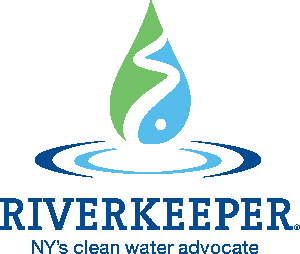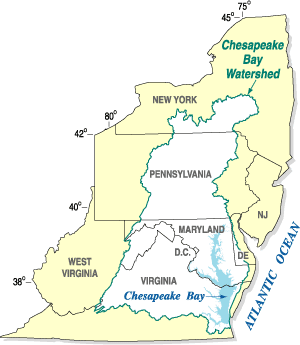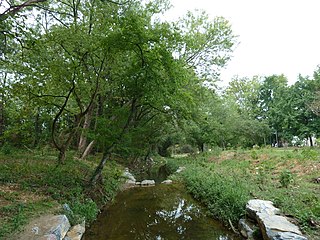
The Potomac River is a major river in the Mid-Atlantic region of the United States that flows from the Potomac Highlands in West Virginia to the Chesapeake Bay in Maryland. It is 405 miles (652 km) long, with a drainage area of 14,700 square miles (38,000 km2), and is the fourth-largest river along the East Coast of the United States and the 21st-largest in the United States. Over 5 million people live within its watershed.

The Patuxent River is a tributary of the Chesapeake Bay in the state of Maryland. There are three main river drainages for central Maryland: the Potomac River to the west passing through Washington, D.C., the Patapsco River to the northeast passing through Baltimore, and the Patuxent River between the two. The 908-square-mile (2,352 km2) Patuxent watershed had a rapidly growing population of 590,769 in 2000. It is the largest and longest river entirely within Maryland, and its watershed is the largest completely within the state.
Waterkeeper Alliance is a worldwide network of environmental organizations founded in 1999 that work to protect bodies of water around the United States and the world. By December 2019, the group said it had grown to 350 members in 46 countries, with half the membership outside the U.S.; the alliance had added 200 groups in the last five years.

The Anacostia River is a river in the Mid Atlantic region of the United States. It flows from Prince George's County in Maryland into Washington, D.C., where it joins with the Washington Channel and ultimately empties into the Potomac River at Buzzard Point. It is about 8.7 miles (14.0 km) long. The name "Anacostia" derives from the area's early history as Nacotchtank, a settlement of Necostan or Anacostan Native Americans on the banks of the Anacostia River.

Rock Creek is a tributary of the Potomac River, in the United States, that empties into the Atlantic Ocean via the Chesapeake Bay. The 32.6-mile (52.5 km) creek drains about 76.5 square miles (198 km2). Its final quarter-mile is affected by tides.

The Monocacy River is a free-flowing left tributary to the Potomac River, which empties into the Atlantic Ocean via the Chesapeake Bay. The river is 58.5 miles (94.1 km) long, with a drainage area of about 970 square miles (2,500 km2). It is the largest Maryland tributary to the Potomac.

Riverkeeper is a non-profit environmental organization dedicated to the protection of the Hudson River and its tributaries, as well as the watersheds that provide New York City with its drinking water. It started out as the Hudson River Fisherman's Association (HRFA) in 1966. In 1986, the group officially changed its name to Riverkeeper, making it the first "keeper" group to be founded. In 1999, the Waterkeeper Alliance was created as an umbrella organization to unite and support "keeper" organizations.

Mattawoman Creek is a 30.0-mile-long (48.3 km) coastal-plain tributary to the tidal Potomac River with a mouth at Indian Head, Maryland, 20 miles (32 km) downstream of Washington, D.C. It comprises a 23-mile (37 km) river flowing through Prince George's and Charles counties and a 7-mile (11 km) tidal-freshwater estuary in Charles County. About three-fourths of its 94-square-mile (240 km2) watershed lies in Charles County, with the remainder in Prince George's County immediately to the north.
Chattahoochee Riverkeeper (CRK) -- formerly known as Upper Chattahoochee Riverkeeper (UCR) -- is an environmental advocacy organization with 10,000 members dedicated solely to protecting and restoring the Chattahoochee River Basin. CRK was modeled after New York’s Hudson Riverkeeper and was the 11th licensed program in the international Waterkeeper Alliance. In 2012, the organization officially changed its name to simply Chattahoochee Riverkeeper (CRK), dropping the "Upper" to better reflect its stewardship over the entire river basin.

The Chesapeake Bay Program is the regional partnership that directs and conducts the restoration of the Chesapeake Bay in the United States. As a partnership, the Chesapeake Bay Program brings together members of various state, federal, academic and local watershed organizations to build and adopt policies that support Chesapeake Bay restoration. By combining the resources and unique strengths of each individual organization, the Chesapeake Bay Program is able to follow a unified plan for restoration. The program office is located in Annapolis, Maryland.
Terry Backer, born Terrance Eddy Backer, was an American politician who served in the Connecticut House of Representatives from 1993 until his death in 2015.
The term Soundkeeper. was first used in the American lexicon by the Long Island Soundkeeper Fund, Inc. in 1987 upon the founding of an environmental protection organization dedicated to the preservation and protection of Long Island Sound. The name and the organization's principles were modeled after the Hudson Riverkeeper Fund. Later, both organizations independently changed their official names to Riverkeeper and Soundkeeper. Soundkeeper and Riverkeeper are founding members of the Waterkeeper Alliance. The term Soundkeeper is a registered trademark of Soundkeeper, Inc. However, it has also become common practice to refer to the lead person who is the water presence of the organization as the "Soundkeeper".

Paint Branch is a 17.0-mile-long (27.4 km) tributary stream of the Anacostia River that flows Southeastwards through Montgomery County and Prince George's County, Maryland. Specifically, its primary tributary is of the Northeast Branch, which flows to the Anacostia River, Potomac River and the Chesapeake Bay. The beginning elevation of the stream is 480 feet above sea level and it subsequently drops to 30 feet when its flows meet the Indian Creek in College Park, Maryland.

Watts Branch is a tributary stream of the Anacostia River in Prince George's County, Maryland, and Washington, D.C.
Alex Matthiessen is an environmentalist and lives in New York City. He is the son of author and naturalist Peter Matthiessen.
The Alliance for the Chesapeake Bay (Alliance) is a regional nonprofit organization that builds and fosters partnerships and consensus to protect and to restore the Chesapeake Bay and its rivers and streams. Their motto is "Together, we can get the job done!".
Coosa River Basin Initiative (CRBI) is a 501c3 grassroots environmental organization based in Rome, Georgia with the mission of informing and empowering citizens to protect, preserve and restore North America's most biologically diverse river basin, the Coosa. Since 1992, the staff, board and members have served as advocates for "the wise stewardship of the natural resources of the Upper Coosa River basin, or watershed, which stretches from southeastern Tennessee and north central Georgia to Weiss Dam in Northeast Alabama. This includes the Coosa River, the Etowah and Oostanaula rivers and the tributaries of these waterways as well as the land drained by these streams and the air that surrounds this land area."

The Interstate Commission on the Potomac River Basin (ICPRB) is an agency composed of commissioners representing the federal government, the states of Maryland, Pennsylvania, Virginia, West Virginia, and the District of Columbia. The ICPRB mission is to enhance, protect, and conserve the water and associated land resources of the Potomac River basin and its tributaries through regional and interstate cooperation.

Between 1947 and 1977, General Electric polluted the Hudson River by discharging polychlorinated biphenyls (PCBs) causing a range of harmful effects to wildlife and people who eat fish from the river. Other kinds of pollution, including mercury contamination and cities discharging untreated sewage, have also caused problems in the river.

Robert Hamilton Boyle Jr. was an environmental activist, conservationist, book author, journalist and former senior writer for Sports Illustrated. In 1966, Boyle founded the Hudson River Fishermen's Association (HRFA) with its members serving as sentries to protect the river and its inhabitants, help reverse the deterioration caused by river pollution, and bring polluters to justice. The organization grew over the years, and in 1986, was officially renamed Riverkeeper after being merged with HRFA's Riverkeeper program. It was the first "keeper" group in the global Waterkeeper Alliance movement.













